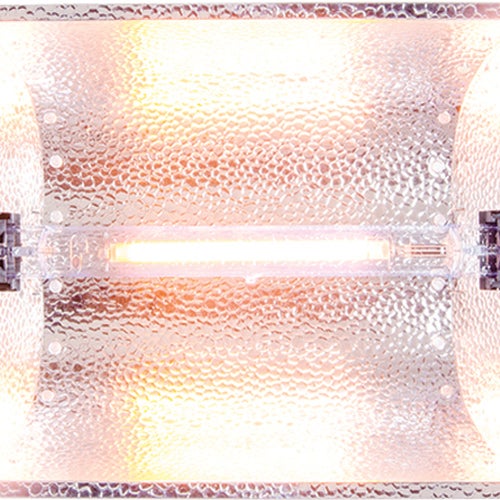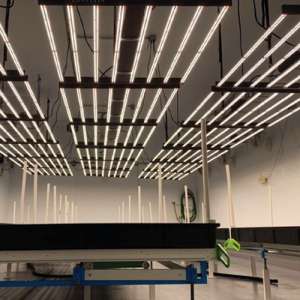Grow Lights
Shop Grow Lights for Home and Commercial Growers
GrowGeneration has the largest selection of grow lights and advanced lighting systems nationwide. Our pricing on DE 1000w lights, LED lights, ceramic metal halide grow lights, fluorescent grow lights, and grow light bulbs are second to none. We have grow lights and lighting equipment from 70+ industry-leading brands, including Fluence LED, Gavita, Phantom, Luxx Lighting, Grower's Choice, and more.
Why Grow Lights Matter
To grow efficiently indoors, plants need artificial light for photosynthesis to happen. Grow lights are key to successful indoor gardening, whether you are using a grow room, grow tent, or a full-scale indoor farm. On top of that, grow lights will boost your yield (compared to traditional outdoor growing), and let you grow your plants all year long, regardless of the season.
Grow Generation has all of the best indoor grow lights for at-home and commercial growers. If you grow plants indoors, we have the lighting fixtures, lamps, and other grow light equipment to make your plants big and strong.
With all the different types of grow lights available, how do you know which one is right for you? Here's a quick rundown of popular grow lighting choices to help you make the best choice for your indoor garden.
Types of Grow Lights for Indoor Plants
Before you shop for grow lights, it's important to know the different options available. There are three main types of grow lights: fluorescent, LED, and HID — each with its own advantages and disadvantages. To help you find the best product for your growing operation, read on for key facts about each grow light type.
Fluorescent Grow Lights
Fluorescent grow lights are a popular choice among growers because they're relatively inexpensive and easy to find. If you're on a budget, these lights are a good alternative. They're not as energy-efficient as LEDs, but they cost less upfront and still provide good coverage.
|
Pros
|
Cons
|
|
-Inexpensive compared to other types of grow lights
-Run cool, so they don't require extra ventilation like HID lights do
-Easier on the eyes than HID lights, making them a good option for people who spend a lot of time working near their plants
|
-Not as effective as HID or LED lights in terms of plant growth
-Require more frequent replacement than HID or LED lights
-Don't last as long as HID or LED lights (usually only last around 10,000 hours)
|
There are three main types of fluorescent grow lights: compact fluorescent lamps (CFLs), T5 grow lights, and T8 grow lights.
- Compact fluorescent lamps (CFLs): CFLs are small, energy-efficient bulbs that can be used for a variety of purposes, including plant cultivation. They come in a wide range of sizes and wattages, so you can find one that's just right for your needs. One downside of CFLs is that they can generate a lot of heat, so be sure to use them with an appropriate cooling system in place.
- T5 grow lights: T5s are slender bulbs that emit high levels of light. They're often used in industrial applications, but they can also be used for plants. One advantage of T5s is that they don't generate much heat, so you won't need to worry about cooling them.
- T8 grow lights: T8s are the most common type of fluorescent light bulb. They're relatively inexpensive and easy to find, and they come in a variety of wattages. T8s emit moderate levels of light, so they're ideal for plants that don't require high levels of light. However, they're not as efficient as other types of fluorescent lights, so you may want to consider other options if energy efficiency is a priority for you.
LED Grow Lights
LED grow lights are becoming increasingly popular, and for good reason. They're energy-efficient, long-lasting, and emit very little heat. However, they can be pricey.
|
Pros
|
Cons
|
|
-Very energy efficient, so they can save you money in the long run
-Longer lifespan than most other types of grow lights (can last up to 50,000 hours)
-Produce very little heat, so they don't require extra ventilation like HID lights do
|
-More expensive than fluorescent grow lights (but still cheaper than HID lights)
-Not as effective as HID lights in terms of plant growth
|
There are three main types of LED grow lights: full spectrum, multi-band, and white.
- Full spectrum grow lights: Typically used during all stages of plant growth, from seedlings to flowers. These lights emit a wide range of wavelengths, from 400nm (blue) to 700nm (red). This allows them to mimic the sunlight that plants would receive outdoors.
- Multi-band grow lights: Used mostly during the vegetative stage, these lights emit a narrower range of wavelengths, usually in the blue and red parts of the spectrum.
- White LED grow lights: used during the flowering stage or for supplemental lighting, these lights emit equal amounts of blue, green, yellow, orange, and red light.
GrowGen’s LED collection includes up to 700W, bar and panel lights, and a selection from 15+ different leading LED grow lighting brands.
HID Grow Lights
High-intensity discharge (HID) grow lights are another popular grow light option. HID lights produce a large amount of light and can be used to grow plants from seedlings to full maturity, but they require more ventilation and generate more heat than other types of grow lights. HID lights require a ballast to operate, and they typically need to be replaced every 1-2 years. They are more typically used in a commercial grow operation, rather than small or home grow operations.
|
Pros
|
Cons
|
|
-Most effective type of grow light in terms of plant growth
-Long lifespan (can last up to 20,000 hours)
|
- More expensive than other types of grow lights
- Give off a lot of heat, so they require extra ventilation in your growing space
- Can be harsh on the eyes if you spend a lot of time working near your plants
|
HID lights are available in two varieties: metal halide (MH) and high-pressure sodium (HPS).
- Metal halide (MH) lights emit a bluish-white light that is ideal for the vegetative stage of plant growth to help plants develop strong stems and leaves. MH lights are also good for clones or seedlings.
- High-pressure sodium (HPS) lights emit a yellowish-orange light that is best for the flowering stage. HPS lights help plants to produce more flowers and fruit. They are also a good choice for plants that require extra light during flowering. HPS lights are very efficient and have a long life span.
GrowGeneration’s HID lighting options include dozens of brand, 3K and 4K lamps, with several different wattage ( 315W, 500W, 630W, 100W) and input voltage options.
Professional Grow Lighting Solutions
Beyond traditional grow lights for indoor gardening in grow rooms, grow tents, and other at-home applications, Grow Generation also supplies commercial grow lights for professionals growing indoor plants at a larger scale.
We even provide bulk grow light pricing and professional grow lighting consultation, upon request.
Choosing the Best Grow Lights for Your Growing Operation
There is no one-size-fits-all answer when it comes to choosing the right type of grow light for your operation. The type of light you choose will depend on factors like budget, energy efficiency, grow space, and desired spectrum of light.
Different types of plants have different light requirements, so it's important to shop around and find the right grow lights for your particular plants. But with the right grow lights, you'll be able to grow healthy plants indoors, year-round.
Contact a GrowGeneration GrowPro today to get your home grow or commercial garden’s grow lighting needs professionally assessed or shop online and pick up in store (available at participating locations).














